We are getting into the the peak of the summer season and almost everybody likes going to the beach, to cool off, play in the water and have fun.
But just like anywhere else you go in the outdoors it’s good to do a little pre-planning and be aware of your surroundings when you get there. In other words: pack your bathing suit, your sunscreen and don’t forget your common sense!
Do your homework in advance and make sure the beach you are going to has Lifeguards on duty. Most city and state beaches in California that are frequented by visitors have Lifeguards, but their hours can be limited, so make sure they will be there when you are there.
Always Swim Near A Lifeguard !
If you are visiting a place unfamiliar to you take the time to speak to the Lifeguards on duty. They will be more than happy to tell you what hazards you should avoid and the safest place to swim. In reality you should do this every time you visit the beach as ocean conditions are always changing.
Your friendly neighborhood Lifeguard is also a great resource for finding the best local spots for fish tacos or whatever else you may be craving after a day at the beach.
Water Hazards
It wasn’t that long ago that being a strong swimmer was considered a type of superpower. Up until the 1950’s there were appalling mass drownings along both coasts that lead to the establishment of professional Lifeguard services on par with any other first responders.
One such incident occurred in the spring of 1918 when in a single afternoon 13 people drowned and another 40 were rescued at Ocean Beach, San Diego. The Lifeguards and citizens that helped repeatedly made rescues until they were so exhausted they couldn’t make another trip out into the water. Larger than normal surf, strong rip currents and an unfamiliar public created a perfect storm for such a calamity.
After this tragedy Lifeguard coverage was increased and augmented by Police officers that were strong swimmers. To this day the badge worn by San Diego Lifeguards is nearly identical to the San Diego Police department’s.
One hundred years later the two leading causes of ocean rescues made by Lifeguards is still due to rip currents and surf. With more people than ever surfing, paddling and swimming it isn’t uncommon for a couple mile stretch of beach to have over a hundred rescues and thousands of preventative acts and warnings made by Lifeguards over the course of a single weekend.
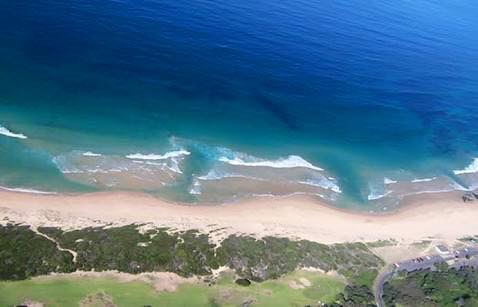
What is a Rip Current?
Rip currents (not riptides) are formed when the water pushed up on the beach by breaking waves needs to flow back out to sea again. Just like in your bathtub the escaping water will naturally find the low point and flow down hill.
This low point on the ocean floor will cut a channel through the near shore sandbar. As time goes on this will get bigger and the rip more defined. As wind and wave action increases the more water will flow and rip currents will grow more intense and can stretch as much as half a mile out to sea.
The period following a set of breaking waves will usually energize the rip currents. An outgoing tide can also cause rip currents to be more active as the water level along the entire beach is basically draining out to sea.
Spotting a Rip Current
A telltale sign of a rip current is a streak or swath of bubbly, brown sandy water stretching away from the beach. If you look close there should be a choppy appearance to the water since it is flowing against the otherwise normal direction of the water flow.
The waves in this area generally won’t break or they will fizzle out due to the increased water depth. The sandbar next to the rip current may be just a few feet deep while the area where the rip is flowing can be over your head. Be very careful of this drop-off especially with small children.
Sometimes you won’t see the sandy water, but you should see an area of water that looks relatively calm, sometimes darker blue, with waves breaking on either side. To most people that looks like the safest place to be, but you will end up walking right into the feeder of the rip.
Rip currents can also be caused by large objects and underwater structures. Rocks, bends in the coastline, piers and jetties will almost always have a rip current on at least one side. This is caused by the water flowing down the coast and running into the obstacle and changing direction. Water cannot be compressed so it will flow around the object and change direction looking for the path of least resistance which is usually out to sea and deeper water.
These types of areas should be given a wide berth or avoided all together. Besides that, swimming under a pier might expose you to dangling fishhooks and you don’t want to be the catch of the day!
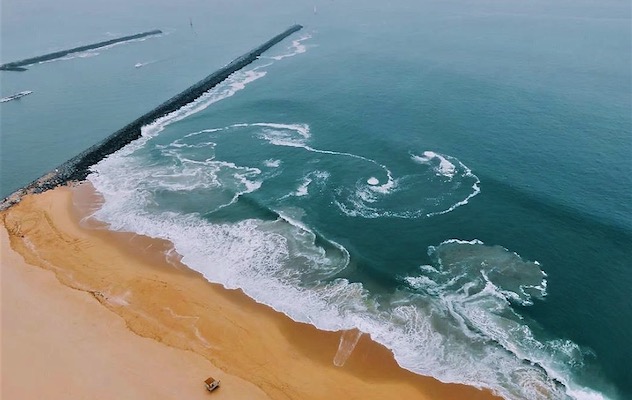
Getting Out of a Rip Current
If you feel yourself being dragged out, remain calm and swim parallel to shore. Your first instinct will be to swim straight in as that is the shortest distance to dry land, but at this point you are in a current that may be flowing faster than you can swim and you will quickly exhaust yourself.
If you feel to tired or unable to figure out which direction to go- try to relax, float and raise your arm to signal you need assistance. If you paid attention at the top you picked a guarded beach and Lifeguards should quickly come to your aid. In reality they probably spotted you before you even hit the water.
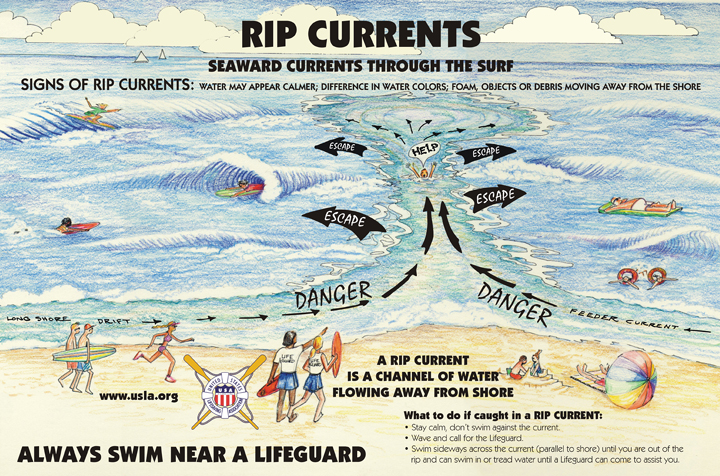
You should consider getting a good pair of swim fins made for use in the ocean. That means shorter blades and an open foot strap, not an enclosed heal. Dive style fins with a full heel cup will pop right off in the surf. Bodysurfing is about the most fun you can have in the ocean. Remember to always keep and arm extended to protect your head and neck from hitting the ocean floor.
You should ALWAYS use the Buddy System. Theres a reason that the number one rule of SCUBA diving is to never go alone. This is important for both adults and children and is a good habit to get into wherever you go in the great outdoors.
Know your limitations
If you aren’t a strong swimmer and the day you come to the beach the waves are huge stay out. Even people who swim regularly in pools will have a tough time in the ocean where the water can be colder and the water and waves much rougher than the chlorinated conditions they are used to.
The same goes for SCUBA divers. We know it would be disappointing to plan a dive trip all year only to find out that on the day of your dive the waves are big, but that’s how it goes sometimes. Don’t press you luck by going out anyway.
When the waves churn up the water there will be no visibility and returning your unused gear is cheaper than a trip to the hospital.
Likewise if you have only done boat dives in the tropics doing beach or rock entries into the ocean is a whole different story and you should go with a local guide who knows the local three R’s – Rocks, Rips and Reefs.
Not knowing the area and terrain underwater is going to set you up for failure. (See Rip Currents Above)
Be honest about your current state of physical conditioning. If just carrying the gear from the car has you huffing and puffing entering the ocean for your first dive in many years is a very bad idea.
Finally, alcohol and swimming don’t mix. As you know a few beers can alter your judgement- we’re looking at YOU lower back tattoo!
Swimming while intoxicated can lead to disastrous results up to and including death. DON’T DO IT.
If the beach you are on allows alcohol on the beach save that for the end of the day when you are done with all water activity.
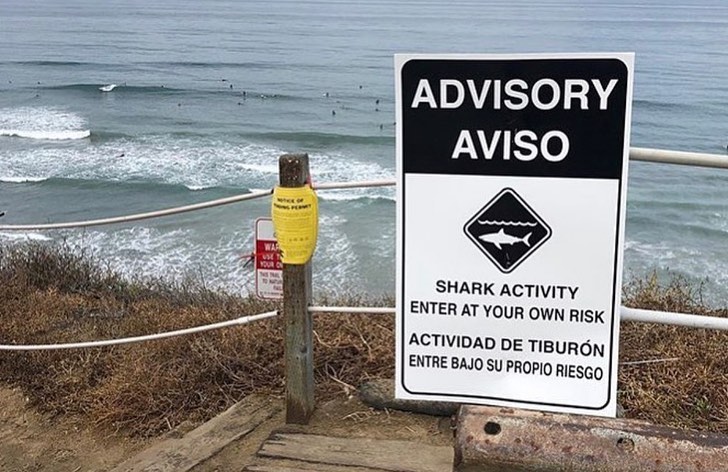
Coastal Cliffs and Bluffs
Many beaches along the west coast a bordered by bluffs and cliffs some higher than 300 feet. When going to a beach near these cliffs there are some safety tips take into consideration.
When going down to the beach it is important to stay on marked trails. Many California Lifeguard agencies have added technical rope rescue to their bag of tricks due to people continuing to get stuck on ledges and hanging drops they thought were a way to the sand.
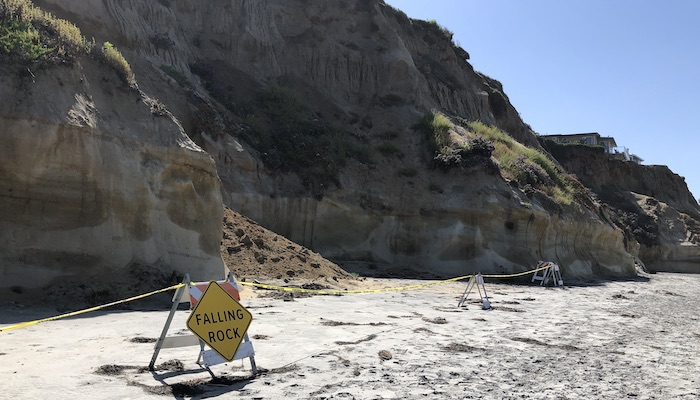
Another precaution to take once down on the beach is to stay away from the base of the cliffs. Rock slides and entire avalanches happen regularly as water seeps through the sandstone and create cracks and eventually cliff collapse. Stay as far out from the cliffs as possible and avoid sitting in front of vertical or overhanging areas.
***Pay attention to all posted signs or asks Lifeguards or locals where the safest place to sit is***
Sea Creatures
“Are there sharks?”
This is probably the number one question asked of Lifeguards by tourists since Jaws hit the screens ‘75 and the answer is YES.
Anytime you enter the wilderness, and the Pacific Ocean is the largest wilderness in the world, your ranking on the food chain drops significantly. There are Great Whites, Hammerheads and Makos, but the reality is they tend to stay in deeper water where there is larger food for them.
You are much more likely to have a run in with a cousin of the shark family, the stingray. Rays like to lurk in shallow water looking for small tidbits to eat like sand crabs. They are pretty well camouflaged on the sandy bottom and have an annoying habit of further covering themselves up with sand so you may only see its eyes or a faintest outline of these cartilaginous creepers.
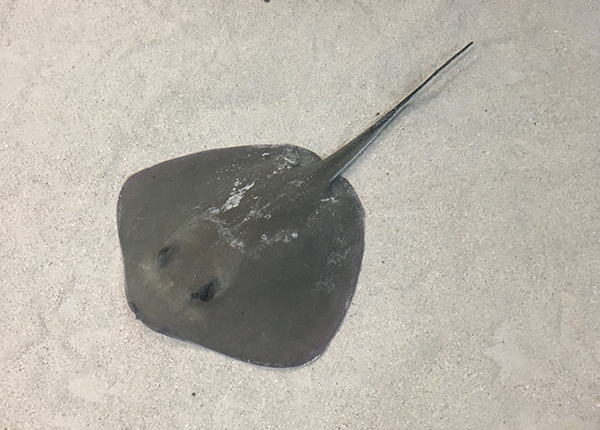
If you step on a stingray you are going to know it.
Their defense mechanism kicks in which is to slash upwards with their tail and the hidden barb underneath to get out from under whatever it is that just stepped on its back.
A stingray wound can look like a pinprick, a long laceration or deep puncture wound. It all depends on what the angle was when it came into contact with you lower leg or foot.
Now the sting- the pain is often described like a giant bee sting and will burn and possibly radiate from the wound site up your leg. Sweating, muscle cramps and some nausea may also present itself.
Remaining calm will help prevent your heart from pumping even harder and spreading the venom. It is thought that those that are allergic to bee stings can have a stronger reaction and possibly experience anaphylaxis but the evidence is mixed.
If there are Lifeguards near they are going to dress your wound to stop any bleeding and then take you to their main tower to soak your foot in hot water. This hot water bath will breakdown the proteins in the venom and after 45 minutes to an hour you should be good to go with just a minor cut and a sea story.
If you are at a beach without facilities you are going to want get to a bath tub as fast as possible and soak your foot in water that is as hot as you can take without burning yourself. (Cold beer and Advil is optional). If someone tells you to urinate on it, they are a weirdo and to be avoided.
If you are really in the middle of nowhere hot packs/compresses and even hot beach sand piled up on the foot can help alleviate the pain.
It is very important that you clean the wound as the barb is covered in a slimy layer that collects bacteria and all of that bad stuff can end up in your wound.
Worst case scenario the barb can break off inside your foot and need to be surgically removed by a doctor. In another rare case the barb will cut a larger blood vessel and bleeding control up to the point of using a tourniquet may be required and then you are going to the emergency room for sure.
Stingrays like to come into shallow water on flat beaches close to shore, where the waves aren’t breaking. When you are walking or wading into the water it is a good idea to shuffle your feet rather than taking big steps. The theory of doing the “Stingray Shuffle” is to get the unseen and unsuspecting stingray to scuttle off rather than you taking a step directly onto his back and then- whaaaamo!
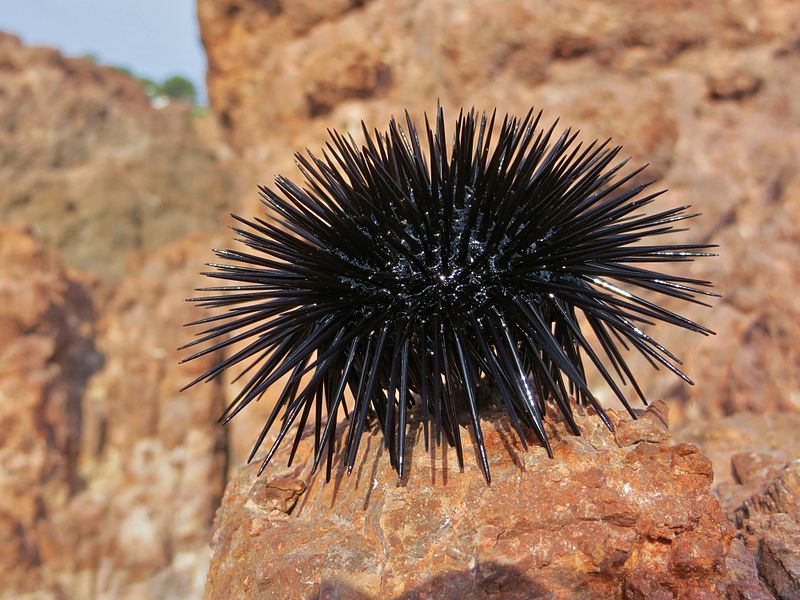
Another spiky sea dweller to watch for is the sea urchin. Urchins usually inhabit rocky reef or the ocean floor among the kelp. From a distance they will look like a a dark blue, black or purple fuzzy sphere, but they are definitely not fuzzy.
They are a slow moving pin cushion that also packs a sting along with infectious slime. If you step on one it is very important to make sure the spine is completely removed. If the spine doesn’t come out you risk it traveling through your body and having it make a painful exit through the front of your shin or elsewhere.

Relatively rare in California, but one more sea creature with a sting to avoid is the Jelly Fish. Their sting can range from excruciating to almost imperceptible to adult skin. Either way you should avoid them so you don’t have to figure out the difference. Also be aware that Jelly Fish can still fire off their sting when they are washed ashore or look dead. This is because they are actually a colony of individual cells and not a single organism. They are definitely a case of look, but don’t touch.
If you are stung vinegar can mitigate the sting, but definitely avoid rubbing the area with your hand. This can cause more of the stinging cells to fire. Similar to removing a bee’s stinger you should scrape the area affected with an object like the edge of your swim fins or use a handful of wet sand.
Marine Mammals
You may see larger sea mammals on your trip to the beach such as Sea Lions and Seals. The easiest way to tell them apart is that seals do not have visible ears on the sides of their heads and get around on land by doing the worm.
Sea lions can move quite quickly on land and both will bite if you approach them so give them the distance they deserve. Additionally, they are protected by Federal law and it is even illegal to “annoy” them- so don’t be annoying.

Children
Even if Lifeguards are present you must keep an eye on your children at all times when you go to the beach. The Lifeguards’ main focus is to watch the water and all the people in it. So, let’s say that again: Watch Your Kids!
Small children can easily get disoriented on a crowded beach and get lost. Remember their line of sight is only a few feet above the ground. All the colorful towels and people blend in to one unfamiliar landscape.
Before any trip to the beach you should have a talk about what to do if they get lost. Remind them to never go in the water without you present and set up a place to meet in case they do get lost.
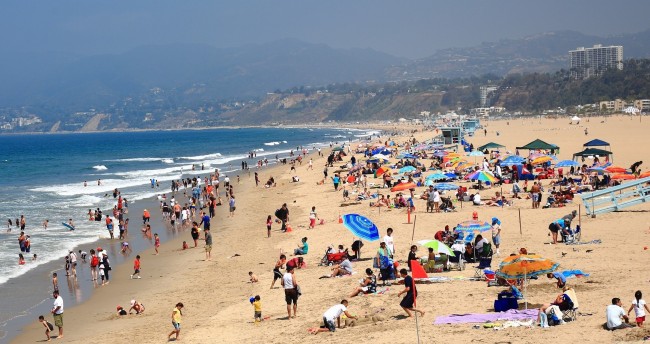
Better still, take them to meet the Lifeguards at the nearby tower and let your child know the people in red trunks with the big patch are there to help and if they do get lost to go directly to the nearest Lifeguard tower. Some children are so well trained not to trust strangers they won’t even get into a Lifeguard truck when they are lost.
Make sure you pay attention to what your child is wearing that day. If your child gets lost have one person stay at your towel area and another go to the Lifeguards with your child’s name, age and description. After that the Lifeguards will share this information over the radio and everybody should be reunited shortly.
This happens all the time at busy beaches, but you should do what you can to avoid it happening in the first place. It’s stressful on your child and takes away from the Lifeguard’s main mission of watching the water and making rescues.
Many times a parent will say they only turned their back for a moment and then their child was gone only to have little johnny found two miles away. Either that child is a future Olympic athlete or that “moment” was much longer than the parent first thought. Keep your nose out of your cell phone and enjoy the scenery.
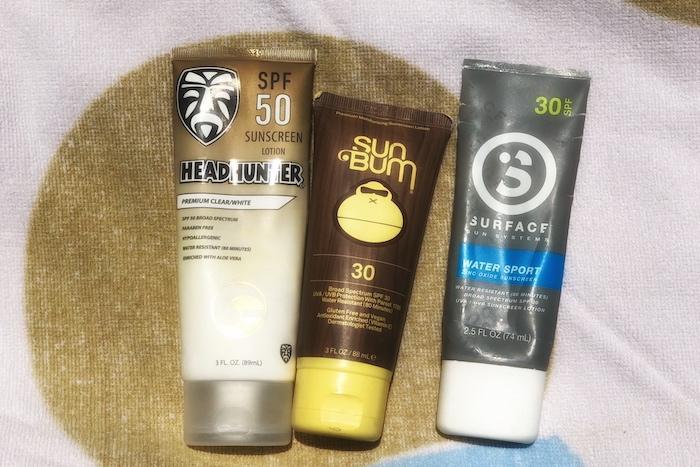
Sun Protection
Skin Cancer is a real concern for people that are active outdoors. The good news is that it’s considered very preventable if the right steps are taken.
We have more knowledge than ever about how to protect ourselves from the harmful effects of the sun, but let’s review:
Select a sunscreen that has broad spectrum protection. That means it filters out both UV A and UV B radiation.
Make sure your sunscreen is not expired. ( Yes it expires just like prescription medication and milk) Select a sunscreen that is PABA free and made for water activities.
Lube up at least 30 minutes before you go to the beach when your skin is cool and dry. Rub it in completely and remember to reapply as directed after sweating or being in the water.
Use enough to thoroughly cover the area you are trying to protect. Don’t forget to get your ears. If you missed a spot you are going to see and feel it later.
Besides sunscreen cover up with a hat and sunglasses on land. Wearing a rash guard is an easy way to cover a large percentage of your upper body and know it won’t get burned.
An umbrella is nice to have for and all day trip to the beach and it can also be a landmark for your children to keep an eye on when playing on the sand.
Part of your sun protection plan should include staying hydrated and not over exerting yourself during the peak of the sun’s heat which is approximately 10:00 to 3:00.
Also, don’t forget shoes or sandals. The sand, sidewalk and dirt trails can get hot enough to cause second degree burns.
For more information on preventing heat and sun related emergencies see our Article Here
Beach Fires
There’s nothing like ending a fun day at the beach with some s’mores and telling sea stories about the giant waves you rode, but just like any campfire you need to be responsible.
Most cities and state parks now require fires to only be allowed in a contained fire pit or in concrete fire rings provided. Children should be warned not to play near fire rings or where there are signs of a fire on the sand as smoldering coals can remain hot enough to cause serious burns for up to 72 hours. Additionally there can be old wire from coat hangers, broken glass and nails buried in the ashes. Severe burns to the bottom of a child feet still happen every year.
You should only burn clean wood that is devoid of all nails, paint or plastics. Make sure you know what type of wood you are burning plants such as oleander and poison oak can produce smoke toxic enough kill you.
Have Fun!
Going to the beach should be fun and relaxing, but you still need to realize the you are in nature just like going to the mountains.
A little bit of preparation, common sense and keeping your wits about you will set you up for a fun day at the beach and a summer to remember- Cowabunga !
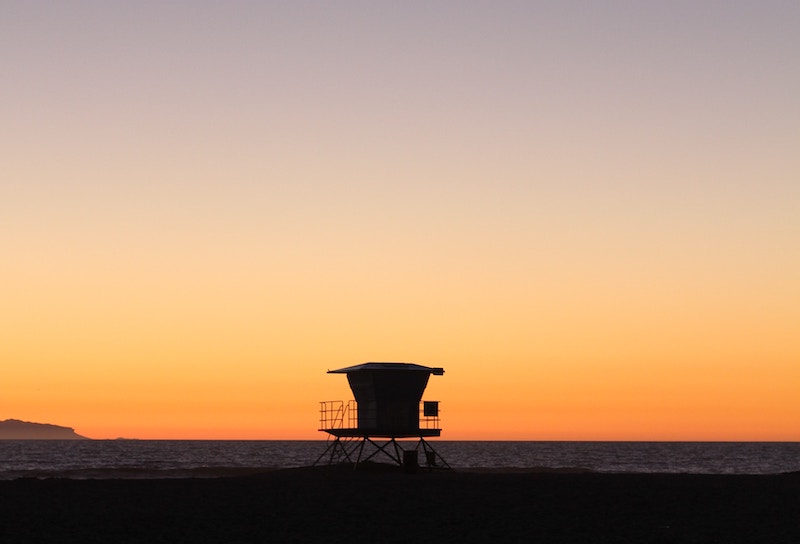



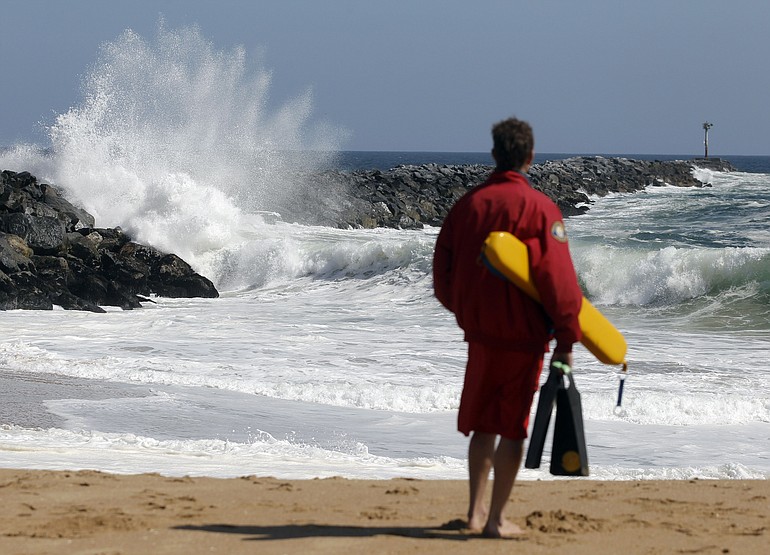

You didn’t forget your towel so – DON’T PANIC. If you’re in trouble in the water, floundering away your energy and becoming fatigued may be your worst enemy. If you are in guarded waters, help will be on the way. Recognize what is going on around you and make a plan, don’t flail.